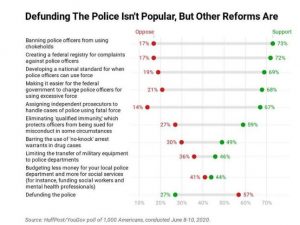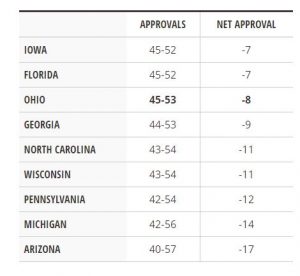The following article by Ruy Teixeira, author of The Optimistic Leftist and other works of political analysis, is cross-posted from his blog:
The protests around the country sparked by the police killing of George Floyd continue to gather support. As measured by Morning Consult polling, support for the protests is now at 62 percent, up from 54 percent a week ago. Other polling shows strong majorities saying the protests are legitimate, justified expressions of dissent not people acting unlawfully or rioting.
No doubt these solid numbers reflect both the popularity of the cause itself and the recent decline in incidents of looting and arson, which threatened to divert attention from the peaceful protests. They also reflect the general view that Trump has done a poor job or handling these protests and resulting social tensions.
As a result, Trump’s overall popularity continues to decline and his standing in trial heat polls vs. Biden has also been slipping. Assuming that protests remain peaceful, Trump may have a hard time regaining more favorable political terrain.
The protests have also raised the profile of police reform as an issue and here there is great potential for progress.. As Conor Friedersdorf summarizes in an Atlantic article, a late May YouGov/Yahoo poll found the following:
“Eighty-nine percent of respondents believe that Floyd’s killer should be charged with at least third-degree murder. “Going forward, Americans largely favor a set of reforms to reduce deadly-force encounters with police,” the poll found. “Sixty-seven percent support banning neck restraints; 80 percent support an early-warning system to identify problematic officers; 87 percent support outfitting all cops with body cameras; and 88 percent training officers to de-escalate conflicts and avoid using force.”
That’s extraordinary––super majorities in favor of broad reforms specifically targeted to reduce unjust killings.”
Good stuff; these kind of reform measures and more are already finding their way into Biden’s platform deliberations and Democratic legislative proposals. Progress seems likely though how much will greatly depend in what happens this November.
It may also depend on the current movement not becoming diverted by quixotic demands that repel potential supporters and muddy the political waters. The most obvious example here is the newly popular (among activists) slogan of “defund the police”. This slogan has been advanced by a number of BLM leaders and just today was spray-painted in huge yellow letters on a downtown Washington street.
Defund the police is terrible idea: it’s toxic as politics and insane as policy. As politics: the overwhelming majority of voters have no interest whatsoever in defunding the police. Political scientist Emily Ekins notes the following:
“[F]ew people support calls to abolish or defund the police: 9 in 10 black, white and Hispanic Americans oppose reducing the number of police officers in their community—and a third say their community needs more officers the Cato survey [on police reform] found. And a Yahoo/Yougov survey found that only 16% of Americans favor cutting funding for police departments, including 12% of whites, 33% of blacks, and 17% of Hispanics.”
In short, people don’t want to get ride of cops, they want better cops. And, as policy, what makes sense is not to get rid of cops but to have more of them. The case for this is very strong, Matt Yglesias wrote a lengthy article summarizing the relevant research over a year ago which repays careful attention at the present time.
“The swing toward greater attention to racial disparities in the criminal justice system and desire to find more humane methods of crime control is long overdue. But there’s a very real risk that in the wake of the leftward swing in the Black Lives Matter era, Democrats are leaving behind genuinely effective and politically appealing approaches to criminal justice that the party has championed in the recent past.
Solid data suggests that even if you take a realistic view of the police, spending money to hire more police officers — an idea espoused by both Presidents Bill Clinton and Barack Obama — is a sound approach to the multifaceted problem of criminal justice. More police officers, in particular, doesn’t need to mean more arrests and more incarceration. More beat cops walking the streets seems to deter crime and reduce the need to arrest anyone. And some of the best-validated approaches to reducing excessive use of force by police officers require departments to adopt more manpower-intensive practices.
In terms of the intersection of criminal justice policy and racial politics, new polling provided exclusively to Vox from the leading Democratic data firm Civis Analytics shows that black voters — just like white ones — support the idea of hiring more police officers. Black voters are likely aware that they are disproportionately likely to be victims of crime and disproportionately likely to benefit from extra police staffing in high-crime areas. Indeed, as Jenée Desmond-Harris wrote for Vox in 2015, one primary grievance African Americans have with the criminal justice systems is that black neighborhoods are paradoxically underpoliced.
Especially with America’s police departments facing staffing challenges as they’re squeezed between tight budgets and a recovering labor market, the political and policy case for more federal help hiring cops is impeccable….
[D]ifferent communities will and do feel differently about the police. But to rely on data rather than anecdotes, Civis Analytics ran a mid-January poll on a range of policing subjects and shared the results with Vox — finding that extra policing is broadly popular across racial groups and that most African Americans and Latinos express favorable views of their local police.
The firm framed the issue this way: “Some members of your state legislature are proposing increasing the budget for the police force and hiring more police officers in high crime areas. If you have to choose, do you support or oppose increasing the number of police officers?”
The results were unequivocally favorable to the proposal, with 60 percent of African Americans, 65 percent of Latinos, and 74 percent of whites saying they support it.
No one issue is going to be decisive in a presidential campaign, and certainly not something as small-bore as federal police funding. But the fact that this idea was embraced by the past two victorious Democratic presidential candidates, is broadly popular, is especially popular with key swing voters, and is also well-grounded in policy amounts to a powerful case that it deserves to make a comeback.
That’s especially true precisely because it’s a slightly odd thematic fit for a Black Lives Matter-conscious Democratic Party. It’s both politically and substantively important for a political movement that wants to advance reforms of the criminal justice system to emphasize that reform does not mean indifference to crime.
Providing money to put more cops on the beat is a proven and cost-effective means of bringing crime down that offers a humane alternative to harsh prison sentences as a deterrent and at least offers some prospect of cutting down on disproportionate use of force as well. The total amount of money involved is, moreover, pretty small. Even at the peak of Obama’s local police funding program, he allocated “only” $1 billion. But the symbolism is large, a clear statement that Democrats take the problem of crime seriously and see the value of police officers’ work…..
It’s one idea from the “tough on crime” 1990s that actually worked out well and deserves to make a comeback in 2020.”
I agree. And need I point out that Donald Trump would love to make this election about defunding the police? One hopes that the somewhat inchoate movement that has arisen to protest George Floyd’s death avoids this trap.





